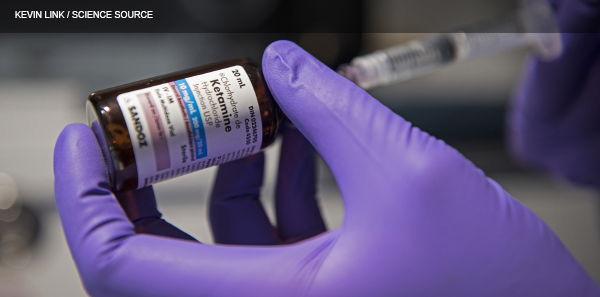
Amid a national opioid epidemic, there is a search for other effective analgesics in the emergency department, both to avoid providing a “fix” as well as to avoid the dangerous side effects of opioids. Recently, ketamine has begun to answer this need. When used at doses greater than 1 mg/kg IV, ketamine has amnestic, sedative, and profound analgesic properties. However, recent research indicates that ketamine’s analgesic properties remain at significantly lower doses. In fact, one review of combat analgesia in the US military characterized ketamine as “an almost ideal analgesic because of its profound pain relief, its potentiation of opioids, its role in preventing opioid hyperalgesia, and its large margin of safety.”1 This article explores the evidence for low-dose ketamine (LDK) for analgesia in the emergency department.
Explore This Issue
ACEP Now: Vol 36 – No 08 – August 2017Efficacy of Analgesia
LDK has been shown to decrease pain scores, both in conjunction with morphine and as a stand-alone treatment.2–5 It is noninferior to morphine when used alone at doses of 0.15 or 0.3 mg/kg. Effective analgesia occurs within minutes and lasts roughly 90 minutes.4 LDK potentiates the effects of morphine and has been uniformly shown to reduce required doses of morphine when administered together.2 Two studies found that 67 percent and 85 percent of patients receiving LDK would like to receive it again for similar pain.3,5
Dosing
Given the markedly different effects between ketamine dosed at dissociative and analgesic doses, attention to dosing is crucial. LDK has been studied from 0.1–0.3 mg/kg, with some studies using a uniform 10 mg or 15 mg dose. Most controlled studies dose ketamine at 0.15 or 0.3 mg/kg as these doses are well-studied in the postoperative anesthesia literature, and this dose range is appropriate for ED use.2 Whether weight-based dosing is required or a uniform dose is acceptable remains unclear. Ahern and colleagues followed initial doses with a 20 mg/hour infusion, which appeared to be superior to push-dose-only LDK, although there was no control group.3
Ketamine is sometimes used as a street drug, and recreational effects traditionally start around 0.4 mg/kg, so higher dosing runs the risk of placing your patient in a psychedelic state, where they may experience some hallucinations or even a partially dissociated state that can be quite distressing to those not seeking that experience.
A large-scale, double-blind, randomized, controlled trial is still needed to effectively determine an optimal dose, whether weight-based dosing is required, and what rate of continuous infusion should be used.
Side Effects
There is a major disconnect between physicians’ perceptions of LDK side effects and reality. In fact, anticipation of emergence reactions is the number-one reason physicians fear the use of LDK in the emergency department.5 However, emergence reactions are nearly impossible with properly dosed LDK, and no true emergence reactions were reported in any study evaluating LDK.2–6 Another common fear of ketamine use is elevation of intracranial pressure (ICP). However, ketamine does not increase ICP even at dissociative doses.7 Furthermore, it does not inhibit respiratory drive to the point of apnea at analgesic doses and only rarely in procedural sedation doses.8 Up to hundredfold (50 mg/kg) overdoses have been reported with no adverse events other than prolonged, otherwise typical sedation.4,8
Pages: 1 2 3 | Single Page





5 Responses to “Low-Dose Ketamine Emerges as Effective Opioid Alternative”
August 21, 2017
Dr. Chuck SwansonI used to live to use it. Would still use it, but in Mississippi ER nurses are not not allowed to monitor patients that have been given moderate sedation. New head of Nursing Board is a NA and made ruling. I work in 2 smaller ERs and it has hampered our ability to care for patients. Can give Versed, a BZD and Fentanyl. Sucks
September 9, 2017
Gabe WilsonChuck,
This same issue crops up all over. The key is, this is not moderate sedation. This is analgesia. In the past Ketamine was only used for sedation so the thought process is locked into using at such.
Change the thinking.
Share the evidence.
In the end, low dose ketamine is much safer the hydromorphone or many of the alternatives.
September 5, 2017
Laura QuintThe bigger issue with ketamine as an analgesic is it’s use outside of the ED – it is all very well if you can discharge home after using but if being admitted you risk misaligned expectations from the patient.
Many places only approve low dose ketamine in the ED, ICU and occasionally the OR/PACU.
What about everyone else?
January 6, 2020
Arnold MillerAny body have experience with using LDK for migraines for heavily pretreated patients?
January 15, 2021
Michelle CostelloSounds quite interesting
Many pain relievets
Are hard on kidneys
And often not effective
Long term
Very interesting